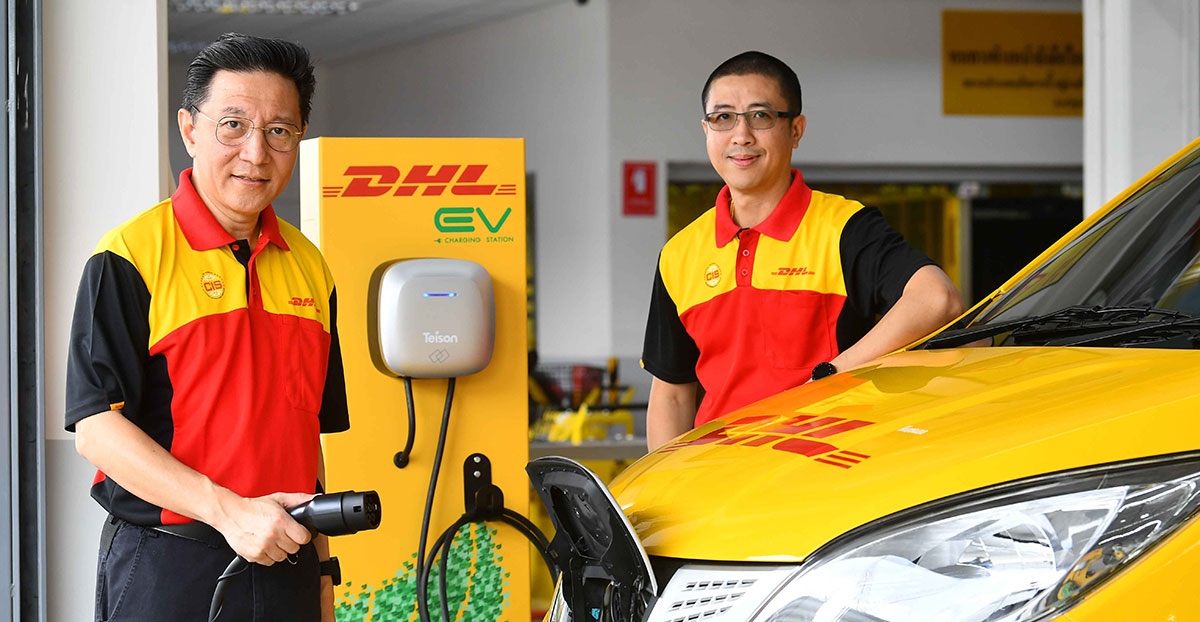- รถขนส่งพลังงานไฟฟ้า 16 คันถูกนำมาใช้สำหรับการขนส่งลาสไมล์ในกรุงเทพฯ
- ภายในปี 2566 ดีเอชแอลจะมีรถขนส่งพลังงานไฟฟ้า 71 คันให้บริการในประเทศไทย
- ดีเอชแอล เอ๊กซ์เพรส ตั้งเป้าการใช้รถขนส่งไฟฟ้า 60% สำหรับการขนส่งสินค้าทั่วโลกภายในปี 2573
ดีเอชแอล เอ๊กซ์เพรส ผู้ให้บริการขนส่งด่วนระหว่างประเทศชั้นนำของโลก ขยายจำนวนยานยนต์ไฟฟ้า (EV) ที่ใช้ในการขนส่งในประเทศไทย โดยเพิ่มรถขนส่งพลังงานไฟฟ้าอีก 16 คัน ในการจัดส่งแบบลาสไมล์ นอกเหนือจากรถมอเตอร์ไซค์ไฟฟ้า 50 คันที่ใช้งานอยู่ในปัจจุบัน การขยายจำนวนการใช้งานรถ EV ในครั้งนี้ทำให้ดีเอชแอล เอ๊กซ์เพรส เป็นผู้ให้บริการลอจิสติกส์รายแรกในประเทศไทยที่เปลี่ยนไปใช้รถ EV ในเชิงพาณิชย์อย่างเต็มรูปแบบ
รถขนส่งพลังงานไฟฟ้านี้เริ่มทำการขนส่งสินค้าในช่วงต้นเดือนมีนาคม 2566 โดยให้บริการในกรุงเทพฯ เขตพื้นที่ต่างๆ ได้แก่ สาทร, สีลม, ปทุมวัน, พระราม 3, ถนนสุขุมวิท, และถนนเพชรบุรีตัดใหม่ โดยดีเอชแอลมีแผนที่จะเพิ่มรถขนส่งพลังงานไฟฟ้าอีก 5 คันในเฟสถัดไป เพื่อใช้งานในเส้นทางภาคตะวันออก ซึ่งจะทำให้ดีเอชแอลมีรถ EV ที่ให้บริการทั้งหมดในประเทศไทยรวมจำนวน 71 คัน ภายในปี 2566 ทั้งนี้บริษัทฯ ตั้งเป้าที่จะเปลี่ยนมาใช้รถ EV เป็นจำนวน 60% ของยานพาหนะทั้งหมดในประเทศไทย ภายในปี 2573
เฮอร์เบิร์ต วงศ์ภูษณชัย กรรมการผู้จัดการ ดีเอชแอล เอ๊กซ์เพรส ประเทศไทย และหัวหน้าภาคพื้นอินโดจีน กล่าวว่า “ความยั่งยืนไม่ใช่เทรนด์ แต่เป็นภารกิจที่เราให้ความสำคัญมาเป็นอันดับหนึ่ง และดีเอชแอลมีแผนการดำเนินงานที่ชัดเจนเพื่อให้บรรลุเป้าหมายที่ตั้งไว้ ในฐานะผู้นำอุตสาหกรรมลอจิสติกส์ระดับโลก เราจำเป็นต้องผลักดันให้ทุกภาคส่วนในอุตสาหกรรมร่วมมือกันเพื่อลดการปล่อยก๊าซคาร์บอนในการดำเนินงานด้านลอจิสติกส์ และเรากำลังเดินหน้าสู่เป้าหมายลดการปล่อยก๊าซคาร์บอนสุทธิให้เหลือศูนย์ ภายในปี 2593 โดยให้ความสำคัญกับการเป็นกรีนลอจิสติกส์ ด้วยการเปลี่ยนไปใช้รถขนส่งพลังงานไฟฟ้า ดีเอชแอล เอ๊กซ์เพรส ประเทศไทย ตั้งเป้าที่จะลดการปล่อยก๊าซคาร์บอนไดออกไซด์ทั้งสิ้น 436 ตันต่อปี โดยรถขนส่งพลังงานไฟฟ้าชุดนี้นับเป็นก้าวสำคัญในการนำเราไปสู่ลอจิสติกส์ที่ยั่งยืน และการสร้างอนาคตที่เอื้อประโยชน์ให้แก่ทุกคน”

รถขนส่งพลังงานไฟฟ้ารุ่นใหม่นี้ใช้เวลา 8 ชั่วโมงในการชาร์จไฟจนเต็ม โดยจะรองรับการเดินทางได้ 260 กิโลเมตร บรรทุกของได้ถึง 3.9 ลูกบาศก์เมตร หรือ 1.6 ตัน รถแต่ละคันจะวิ่งขนส่งรวมระยะทาง 3,000 กิโลเมตรต่อเดือน โดยมีระบบเบรก ABS, ระบบล็อคอัตโนมัติ, สัญญาณเตือนโดยใช้เซ็นเซอร์, และระบบควบคุมการกระจายแรงเบรก (EBD) ซึ่งเป็นคุณสมบัติมาตรฐานที่สร้างความปลอดภัยในการขับขี่ให้กับพนักงานขนส่ง
สแลมล็อค (Slam Lock) เป็นระบบรักษาความปลอดภัยเสริม โดยจะล็อคประตูรถทุกบานโดยอัตโนมัติเมื่อผู้ขับรถปิดเพียงประตูเดียว ซึ่งจะช่วยเพิ่มความปลอดภัยเมื่อผู้ขับไม่ได้อยู่กับตัวรถ ระบบเทเลเมติกส์ที่ติดตั้งอยู่ในรถยนต์ไฟฟ้าทุกคันจะบันทึกข้อมูลจากกล้องด้านหน้า ด้านใน และด้านหลัง ทำให้สามารถตรวจสอบและแจ้งเตือนความปลอดภัยแบบเรียลไทม์เมื่อเกิดเหตุเกี่ยวกับรถและผู้ขับรถได้ทันที
ศิวเวศม์ หงษ์นคร รองประธานฝ่ายปฏิบัติการ ดีเอชแอล เอ๊กซ์เพรส ประเทศไทย กล่าวเสริมว่า “นับเป็นอีกก้าวที่สำคัญของเราในการเดินหน้าลดการปล่อยก๊าซคาร์บอน ทำให้กรีนลอจิสติกส์และอนาคตที่ยั่งยืนมีความหมายมากขึ้น ภายในปีนี้ รถขนส่งพลังงานไฟฟ้าสำหรับการขนส่งลาสไมล์ของดีเอชแอล เอ๊กซ์เพรส จะเพิ่มเป็น 29 เปอร์เซ็นต์ของจำนวนยานพาหนะทั้งหมด และเราจะยังคงมุ่งมั่นดำเนินการอย่างต่อเนื่องในฐานะผู้บุกเบิกตลาดในการลดการปล่อยก๊าซคาร์บอนไดออกไซด์ เพื่อสภาพภูมิอากาศที่ดีขึ้น”
ด้วยการใช้รถขนส่งพลังงานไฟฟ้า ดีเอชแอล เอ๊กซ์เพรส ประเทศไทย จะสามารถลดปริมาณการปล่อยก๊าซคาร์บอนไดออกไซด์ได้ 436 ตันต่อปี ดีเอชแอลได้พัฒนาโครงสร้างพื้นฐานเพื่อรองรับการใช้รถ EV รวมถึงการเพิ่มจุดชาร์จอัจฉริยะที่ศูนย์บริการเพื่อรองรับปริมาณรถ EV ที่จะเพิ่มขึ้นในปีนี้
ความริเริ่มนี้เป็นส่วนหนึ่งของเป้าหมายระดับโลกของกลุ่มบริษัทด๊อยช์โพสต์ ดีเอชแอลที่จะใช้ยานยนต์ไฟฟ้า 60% เพื่อการขนส่งลาสไมล์ภายในปี 2573 นอกจากการเปลี่ยนผ่านในการใช้รถ EV แล้ว บริษัทยังสร้างการขนส่งที่เป็นมิตรกับสิ่งแวดล้อม รวมถึงการตั้งเป้าผสมผสานการใช้เชื้อเพลิงยั่งยืนในการขนส่งด้วยเครื่องบิน (Sustainable Aviation Fuels) ให้ได้มากกว่า 30 เปอร์เซนต์ ภายในปี 2573, การออกแบบอาคารที่ลดคาร์บอน และนำเสนอผลิตภัณฑ์ที่เป็นมิตรต่อสิ่งแวดล้อม เช่น บริการ GoGreen Plus ที่ดีเอชแอลเพิ่งเปิดตัวไปเมื่อเร็วๆ นี้ เพื่อช่วยลูกค้าในการลดการปล่อยก๊าซเรือนกระจก
เพื่อให้สอดคล้องกับกลยุทธ์ด้านความยั่งยืน กลุ่มบริษัทด๊อยช์โพสต์ ดีเอชแอลจะลงทุนเป็นจำนวน 7 พันล้านยูโร ในด้านมาตรการลดการปล่อยก๊าซคาร์บอนไดออกไซด์ จนถึงปี 2566 ซึ่งรวมถึงการเพิ่มจำนวนรถ EV ทั้งนี้ ดีเอชแอล เอ๊กซ์เพรส วางแผนที่จะใช้รถ EV มากกว่า 1,000 คันในเอเชียแปซิฟิกภายในปี 2567
การขยายไปสู่การใช้รถขนส่งพลังงานไฟฟ้าในครั้งนี้ของดีเอชแอล ได้สอดคล้องกับนโยบาย 30@30 ของประเทศไทย ซึ่งมีเป้าหมายในการทำให้รถยนต์ 30% ในประเทศเป็นรถยนต์ที่ปล่อยมลพิษเป็นศูนย์ (ZEV) ภายในปี 2573 โดยประเทศไทยมุ่งมั่นที่จะพัฒนาไปสู่สังคมคาร์บอนต่ำ และตั้งเป้าเป็นศูนย์กลางการผลิตรถยนต์ไฟฟ้าและชิ้นส่วนยานยนต์ในภูมิภาคอาเซียน
